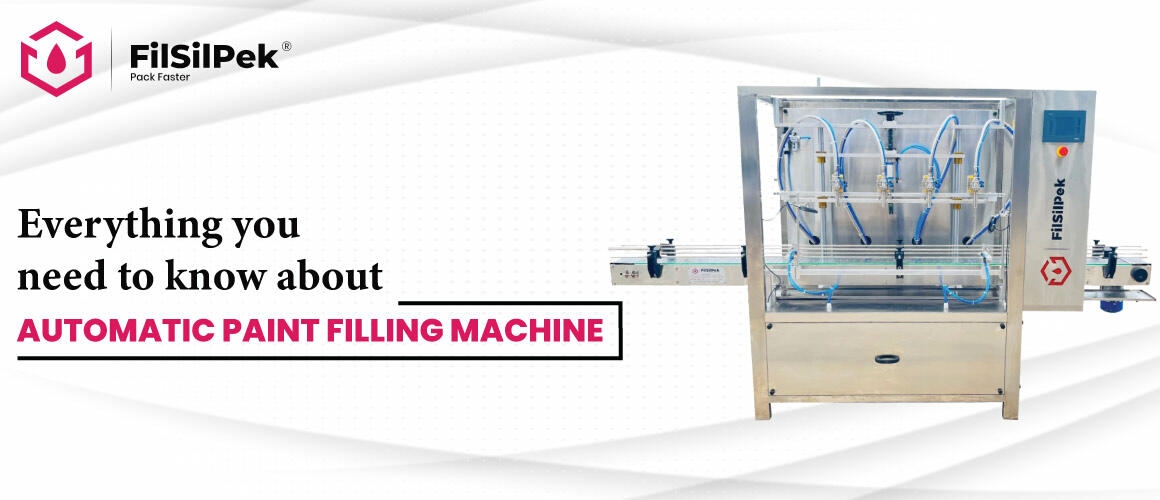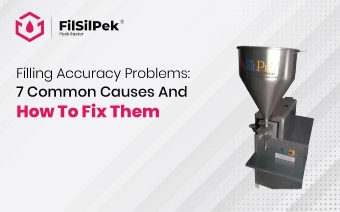Everything you need to know about Automatic Paint Filling Machine
Painting has been an essential aspect of human expression and innovation for centuries. However, with the increasing demand for quality and efficiency, the traditional methods of paint production and packaging face numerous challenges. From ensuring consistency in color and texture to meeting stringent safety standards, the paint industry is constantly evolving to meet the demands of the modern world.
With growing involvement of technology in business world, automation emerges as the prime factor of efficiency and accuracy. Like all other industries, paint industry is also not behind in adopting the automation into its production and packaging process.
Automatic paint filling machines are at the forefront of this transformation, offering a seamless solution to the complexities of the filling and packaging process.
This article talks about how this innovative technologyis revolutionizing the paint production industry and making a remarkable difference in business.
Understanding the Paint Production Process
Raw Material Preparation:
Raw materials, including pigments, binders, solvents, and additives, are sourced from suppliers and subjected to rigorous quality checks to ensure consistency and purity. Once approved, these materials are weighed according to predefined formulations, ensuring precise proportions for the desired paint properties.
Mixing and Grinding:
The weighed raw materials are then mixed together in specific ratios to achieve the desired color, texture, and performance characteristics of the paint. This mixing process is often followed by grinding and dispersion, which involves reducing particle size and enhancing color intensity and uniformity. Various equipment such as bead mills, ball mills, or three-roll mills are utilized for efficient particle size reduction and distribution.
Quality Control and Adjustments:
Throughout the production process, quality control measures are implemented to maintain product integrity and adherence to specifications. The paint mixture undergoes filtration to remove any impurities or oversized particles that may affect the final product quality. Additionally, rigorous testing is conducted to evaluate properties such as viscosity, pH, density, and color consistency. Based on testing results, adjustments to the paint formulation may be made to ensure it meets the desired standards and performance criteria.
Packaging and Distribution:
Once the paint formulation has passed quality control checks and meets specifications, it is ready for packaging. Automated filling machines are employed to fill containers, such as cans, bottles, drums, or buckets, with the paint formulation. Labels are applied, and containers are sealed to prepare them for distribution and sale. Proper handling and storage practices are followed to maintain product integrity and extend shelf life until the paint products reach retailers or customers.
The Role of Automatic Paint Filling Machines in the Packaging Process of Paint:
Automatic paint filling machines play a pivotal role in the packaging process of paint, offering efficiency, precision, and safety. These machines streamline the filling, capping, and labeling of paint containers, significantly reducing production time and labor costs.
Equipped with advanced technology, including sensors and programmable logic controllers (PLCs), automatic filling machines ensure accurate measurements and consistent filling levels, minimizing product wastage and maximizing productivity.
By automating the packaging process, these machines eliminate the potential for human error and variability, resulting in uniform product quality and appearance. They can handle a wide range of paint viscosities and container sizes, providing versatility and flexibility to paint manufacturers.
Moreover, automatic filling machines are designed with built-in safety features to prevent spills, accidents, and contamination, ensuring compliance with regulatory standards and promoting a safe working environment.
How Automatic Paint Filling Machines Work?
- Container Placement: Empty containers are placed onto the conveyor belt of the automatic paint filling machine.
- Filling Operation: The machine dispenses paint into each container with precision, controlled by sensors and PLCs.
- Level Sensing: Sensors monitor the filling level to ensure accuracy and prevent overfilling or underfilling.
- Capping and Sealing: Caps or lids are applied and securely sealed onto the filled containers to prevent leakage or contamination.
- Labeling (optional): Labels may be applied to the containers, providing product information and branding.
- Quality Inspection: The machine may incorporate mechanisms for quality inspection to ensure consistency and quality of filled containers.
Types of Paint Filling Machines
1. Semi-Automatic Filling Machines:
- Semi-automatic paint filling machines require some manual intervention during the filling process.
- Operators are typically responsible for tasks such as container placement, initiation of the filling cycle, and monitoring of the filling levels.
- These machines offer flexibility and are suitable for small to medium-scale paint production operations.
- Semi-automatic machines are often more affordable than fully automatic options and are ideal for businesses with budget constraints or lower production volumes.
2. Fully Automatic Filling Machines:
- Fully automatic paint filling machines operate with minimal or no manual intervention, automating the entire filling process.
- These machines are equipped with advanced technology, including sensors, PLCs, and robotics, to handle tasks such as container handling, filling, capping, and labeling.
- They offer high-speed operation, increased efficiency, and precision, making them ideal for large-scale paint production facilities with high production volumes.
- Fully automatic machines require less operator involvement, reducing labor costs and minimizing the risk of human error.
- While initially more expensive than semi-automatic machines, fully automatic filling machines offer long-term cost savings and improved productivity for manufacturers.
Advantages of Automatic Paint Filling Machine
Automatic paint filling machines offer several advantages in various industrial and commercial settings:
Programmable Filling Parameters:
Automatic paint filling machines offer the ability to program specific filling parameters such as fill speed, fill volume, and container size. Manufacturers can customize these settings to optimize the filling process for different types of paint products, ensuring precise and efficient filling operations.
Integration with Production Line Automation:
These machines can be seamlessly integrated into existing production line automation systems, allowing for continuous and synchronized operation with other manufacturing equipment such as conveyors, labelers, and capping machines. This integration streamlines workflow processes and enhances overall manufacturing efficiency.
Advanced Control Systems:
Automatic paint filling machines are equipped with advanced control systems, including PLC (Programmable Logic Controller) technology and HMI (Human-Machine Interface) panels. These systems offer real-time monitoring and control capabilities, allowing manufacturers to closely manage the filling process, troubleshoot issues, and make rapid adjustments as needed to optimize performance and maintain production uptime.
Non-Contact Filling Methods:
Some automatic filling machines utilize non-contact filling methods such as gravity filling or servo-driven piston filling. These methods minimize product foaming, splashing, and air entrapment during the filling process, resulting in more accurate fill levels and reduced product waste. Additionally, non-contact filling helps preserve the integrity of sensitive paint formulations and reduces the risk of contamination.
Integrated Quality
Assurance Features: Automatic paint filling machines often include integrated quality assurance features such as vision inspection systems and weight verification systems. These features enable manufacturers to perform real-time quality checks on filled containers, ensuring compliance with specified fill levels, detecting any defects or anomalies, and maintaining product consistency and quality standards.
Remote Monitoring and Diagnostic Capabilities:
Many modern automatic filling machines offer remote monitoring and diagnostic capabilities via network connectivity and IoT (Internet of Things) technology. Manufacturers can remotely access machine data, performance metrics, and diagnostic information from anywhere with an internet connection, allowing for proactive maintenance, troubleshooting, and optimization of machine performance to minimize downtime and maximize productivity.
What factors should be considered when choosing a paint filling machine?
When selecting a paint filling machine, several crucial factors must be carefully considered to ensure optimal performance and efficiency in the production process. Each aspect plays a significant role in determining the suitability of the machine for specific production requirements and operational needs.
Let’s explore some key considerations to keep in mind when choosing a paint filling machine:
- Production Volume: Consider the anticipated production volume to choose a filling machine that can meet your capacity requirements efficiently.
- Paint Viscosity: Select a machine capable of handling the viscosity of your paint product to ensure smooth and accurate filling.
- Container Size and Shape: Ensure the filling machine is compatible with the size and shape of your containers to prevent compatibility issues.
- Filling Speed: Evaluate the filling speed of the machine to determine if it aligns with your production goals and timelines.
- Accuracy and Precision: Look for machines that offer precise filling levels to maintain product consistency and minimize wastage.
- Flexibility and Versatility: Choose a filling machine that can accommodate various paint types, viscosities, and container sizes for added flexibility in production.
- Ease of Maintenance: Consider the ease of maintenance and availability of spare parts to minimize downtime and ensure continuous operation.
- Budget and ROI: Assess the upfront cost of the machine against its long-term benefits and return on investment to make a cost-effective decision.
How much does a liquid filling machine cost?
The cost of a liquid filling machine can vary based on factors such as capacity, features, and brand.
Generally, for basic models with lower capacities, prices may start from around ₹50,000 to ₹1,00,000. However, for high-capacity, fully automated systems with advanced features, prices can exceed ₹10,00,000 or more.
It’s essential to consider your specific production needs and budgetary constraints when selecting a liquid filling machine. To understand more on pricing, contact us now.
Frequently asked questions about Automatic Paint Filling Machine
How Automatic paint filling machine ensures safety in the packaging process?
Automatic paint filling machines are equipped with safety features such as sensors, emergency stop buttons, and protective enclosures to prevent accidents and ensure operator safety.
What type of containers does a paint filling machine handle?
Paint filling machines can handle various types of containers, including cans, bottles, jars, and drums, depending on the machine’s specifications and customization options.
What type of paints are suitable for a paint filling machine?
Automatic paint filling machines are designed to handle a wide range of paint viscosities, including latex, enamel, acrylic, and solvent-based paints.
What maintenance is required for a paint filling machine?
Regular maintenance, including cleaning, lubrication, and inspection of components, is essential to ensure optimal performance and longevity of a paint filling machine.
How can I ensure accuracy with an automatic paint filling machine?
To ensure accuracy, it’s essential to calibrate the machine regularly, use high-quality components, and monitor the filling process closely for any deviations.
Conclusion:
Automatic paint filling machines represent the future of paint production, offering unparalleled efficiency, consistency, and safety. By embracing automation, paint manufacturers can overcome the challenges posed by traditional filling methods and meet the evolving demands of the industry. With advanced technology and innovative solutions, these machines pave the way for a brighter and more efficient future in the world of paint production.
Want to know more about automatic paint filling machine? – connect our experts now or write us at [email protected]
Filling accuracy problems: 7 common causes and how to fix them
In every production unit where filling is at the heart of operations…
Why your viscosity changes are messing up your filling results
If you run a business where product filling drives your daily output, you already know how tricky it gets to keep…


